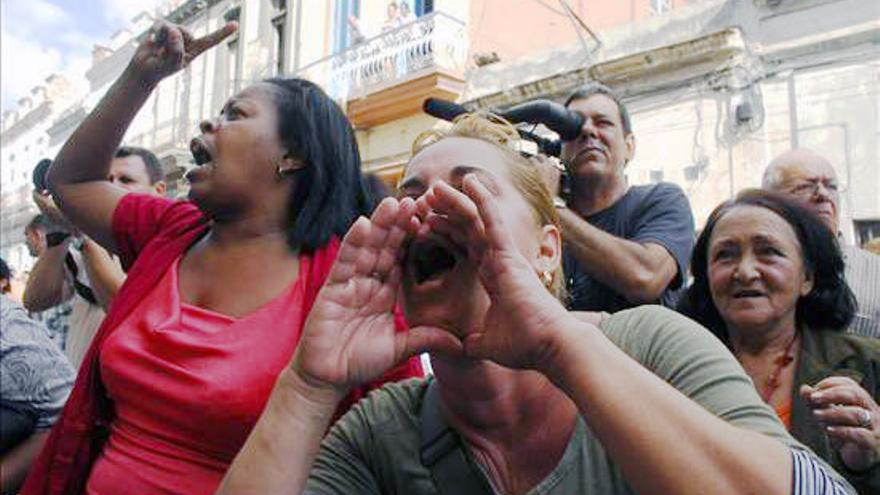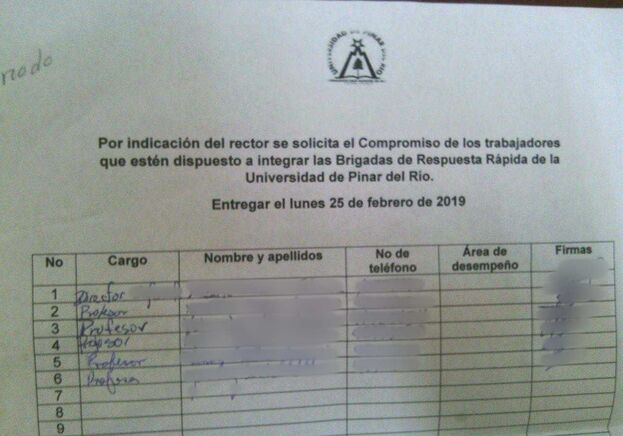
![]() 14ymedio, Marcelo Hernández, Havana, 14 April 2019 — In several Cuban universities, professors and directors are being required to ratify their membership in the Rapid Response Brigades (BRR), para-police groups destined to confront popular protests. Teachers must sign a document with the commitment to join these groups, according to testimonies and documents collected by 14ymedio.
14ymedio, Marcelo Hernández, Havana, 14 April 2019 — In several Cuban universities, professors and directors are being required to ratify their membership in the Rapid Response Brigades (BRR), para-police groups destined to confront popular protests. Teachers must sign a document with the commitment to join these groups, according to testimonies and documents collected by 14ymedio.
“At the end of February they circulated a page where each teacher had to put their name, position and phone number, in addition to adding their signature as a commitment to be part of the Rapid Response Brigades,” a young professor at the University of Pinar del Rio who preferred anonymity told this newspaper. “Everyone in my department, we all signed,” adds the teacher who works in the computer area.
Since its inception in the early 90s, the Rapid Response Brigades were conceived as a vigilante organization that controlled outbreaks of popular dissent. The Cuban authorities wanted to avoid the image of uniformed people repressing the people and founded these bodies of “brown shirts” as the first ring to neutralize the protests.
The BRRs have had a particult participation in acts of repudiation against opponents and activists, especially against the Ladies in White movement. But their consecration arrived in August 1994, when together with the police and armed with sticks they faced those who took to the streets in the popular revolt known as El Maleconazo which was the preamble to the so-called Crisis de los Balseros (Rafters Crisis).
“I was surprised because I had not heard about these brigades for years, but I think that now it is something more formal, that they will never call us to do anything,” says the professor from Pinar del Río. “A colleague of mine was on leave in those days and they called her to come and sign because they said it was very important and that the country is going through difficult times in which there are new threats.”
The form, to which 14ymedio had access, details that the commitment is carried out at the request of the rector of the “Hermanos Saíz Montes de Oca” University of Pinar del Río (UPR), the doctor of educational sciences, Yorki Major Hernández. Graduated initially with an English Degree, Major Hernández was promoted from teaching and administrative positions to reach his current position.

This newspaper contacted by telephone several of the professors that appear in the commitment document, but none of them wanted to make statements about their affiliation with the Rapid Response Brigades. Nor did they deny the authenticity of the return or the process of reactivation of these shock troops. “I have every right to belong to whatever I want,” said one of them before hanging up the phone in the middle of the conversation.
“The Rapid Response Brigades have never ceased to exist in Artemisa,” says Niurka, 42, who lives in the municipality of Candelaria. “Last year, when Defense Day was held in this area, many workers from the state sector were mobilized and contingency exercises were carried out in case of massive protests, the members of the Rapid Response Brigades were summoned.”
“In order to expand knowledge and learn to face special situations,” was now the call for these practices was reflected the local press. “It was nothing secret, it came out in the newspaper, but of course it caught our attention to talk about something that many thought had ended that it was a Special Period,” adds Niurka.
In the training, Niurka recalls that they insisted that the people themselves had to “defend the Revolution” and they were taught some techniques to “keep [the protesters] silent, avoid their shouting counterrevolutionary slogans and even how to immobilize” elements disaffected to the process. They also emphasized “being careful not to present an image of physical violence to people who are recording with mobile phones.”
Unlike the decade of the 90s, when communications on the island were very precarious, Cubans are now making more and more intense use of mobile phones and social networks. In recent months there have been viral images of protests against Miguel Díaz-Canel’s caravan in a neighborhood affected by a tornado in Havana and numerous images of violent arrests of activists.
A report of the Inter-American Commission on Human Rights, dated October 1996, described the BRR as groups that “the Cuban government throws into the streets with weapons and clubs to beat its opponents.”
The BRRs have not been deactivated since they were created almost 30 years ago but have languished in the last decade. Now, with the increase in social unrest due to the rise in food shortages, the deterioration of public services and the rising cost of living, the authorities seem worried about a possible social explosion and are dusting off these vigilante groups.
Teachers of the “Marta Abreu” Central University of Las Villas and of the Havana José Antonio Echeverría Technological University, also confirmed to this newspaper that a similar form has circulated in recent weeks among professors, administrators and directors of these centers of higher education. So far there is no confirmation that the commitment has also been extended to the students.
The reactivation of the BRRs revives the memory of many who were part of these groups or were victims of their acts of repudiation.
Roberto, 68, who emigrated to Miami remembers that day very well. “I worked in a warehouse on Zanja Street in Centro Habana when they told us there was a provocation near the Ameijeiras Hospital and that we had to go out and confront it,” he recalls now, using a pseudonym. “They gave us construction workers’ helmets and rods, but on the way I lost the group on purpose because I knew I was not going to be able to hit anyone.”
Now, working with a contractor repairing homes in Florida, Roberto says he could not fulfill his duty as a member of the BRRs in part because his eldest son “had left that early morning for the Regla Ferry because the rumor had spread that they were going to leave for the United States.” Just thinking that “among those who were going to take hits was my son, paralyzed me.”
Finally the young man managed to get out on a raft, be picked up by the US Coast Guard and settle in Miami. A decade later, he managed to get his parents out of the island. However, Roberto rarely tells his story because he fears that they will point him out in public as a member of the BRR, a past membership that could cost him his residence in the US.
Recently, the Foundation for Human Rights in Cuba (FDHC), based in Miami, launched the Cuban Repressors initiative, to “identify, investigate and collect information on the military (MININT / MINFAR) or paramilitaries (Rapid Response Brigades)” that exercised “violent political repression against the citizens” and now live in the United States.
“I signed up not to lose my job but I never hurt a fly,” says Roberto. “Although I do remember co-workers who enjoyed coming out with the od to break their heads, but most of them do not want to remember that now, and many even live here in the United States and they show themselves to be tremendous anti-Castro people.”
______________________
The 14ymedio team is committed to serious journalism that reflects the reality of deep Cuba. Thank you for joining us on this long road. We invite you to continue supporting us, but this time by becoming a member of 14ymedio. Together we can continue to transform journalism in Cuba.
